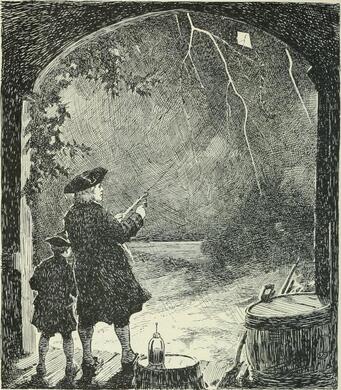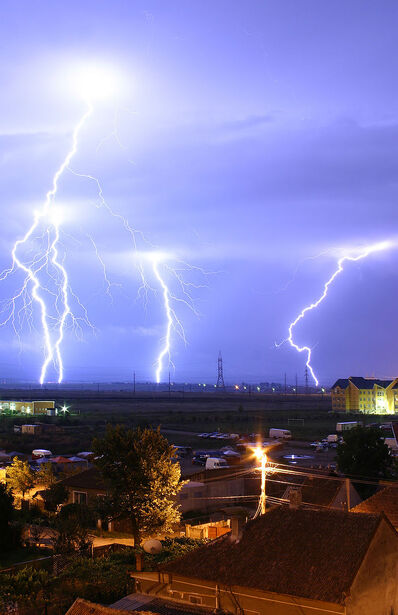|
I recently visited the town of Salem, Massachusetts and stopped by the Old Burying Point cemetery. This cemetery, started in 1637, is the second oldest in the United States. Among the dead in this cemetery are both famous, as well as infamous denizens of early Salem days, such as those who presided over the Salem witch trials and sentenced alleged witches to death. However, one grave caught my attention because it has a large tree growing on top of it. This tree in Salem is known as “the lightning tree” due to the fact that over the years it has been struck by lightning multiple times, and one of its sides is severely damaged. The tree is remarkable not only because it is the only tree in the cemetery that has been repeatedly struck by lightning, but because of the manner in which the person interred below the tree died. The tombstone reads: HERE LYES INTERRD THE BODY OF MR CALEB PICKMAN WHO DIED JUNE 4th. 1737. (BEING STRUK WITH LIGHTNING) AGED 22 YEARS. My times are in thy hand O Remember my Life is Wind The irony that someone killed by lightning has a tree growing over his grave that has been hit itself several times by lightning has not been lost on the locals who have incorporated Caleb’s story into the town’s supernatural lore. Thus it is said that Caleb’s tree is hit by lightning every 22 years (the age he was when he died), and his soul will never rest until the tree is destroyed by lightning. Caleb is also famous because his surname is tied to an unsettling story by the late horror writer H. P. Lovecraft entitled “Mr. Pickman’s Model” in which the protagonist was said to be from “old Salem stock” and to have had a witch ancestor that was hanged in Salem in 1692. Caleb seems to be the only one in the Old Burying Point cemetery that died in this way, and, to my knowledge, Caleb’s tombstone may be the oldest surviving tombstone in the United States which states that the occupant of the grave was killed by lightning. Being killed by lightning certainly was not a very common occurrence in Salem in those days, although lighting was often viewed in the American Colonies with awe and reverence. The same was true in 18th century Europe where the fascination people experienced with lightning was often expressed with religious overtones.  Franklin's Kite Experiment Franklin's Kite Experiment Since the dawn of humanity, lightning has been associated with the Gods or considered one. Although Europeans had ample knowledge regarding the generation of static electricity, and had even developed many popular parlor tricks that employed electricity, the nature of lightning generated during thunderstorms remained mysterious. This changed in 1752 (fifteen years after Caleb’s demise) when Benjamin Franklin performed his famous kite-in-a-thunderstorm experiment. In this experiment Franklin demonstrated that lightning was electricity and could be used to charge a Leyden jar, which is a device that stores electric charge and nowadays is called a capacitor. In this way lightning became just another natural phenomena; an oversized version of the sparks seen in parlor tricks that amused crowds in Europe. A few years later, Franklin also invented the lightning rod, which quickly spread through the colonies and Europe protecting structures and the people within them from lightning. Franklin and others continued their investigations, but the emphasis of the research focused on electricity and its potential applications. Luigi Galvani discovered animal electricity in 1780. Alessandro Volta invented the battery in 1800. Michael Faraday invented the electric motor in 1821. Samuel Morse and others developed and implemented commercial telegraphy between the 1840s and 1860s, which was later replaced by wireless versions. Alexander Graham Bell invented the telephone in 1876. Thomas Edison produced the first long-lasting electric light bulb in 1879 and developed direct current (DC) setting the stage for his rivalry (War of the Currents) with George Westinghouse and Nikola Tesla who favored alternating current (AC) to electrify America. As American society became more dependent on machines and electricity, the need arose to study how they were affected by lightning. Additionally, the population of the United States increased into the hundreds of millions with a concurrent rise in lightning fatalities. By the early 1900s, an average of 4-5 lightning deaths per one million people occurred in the United States every year.  Work by Charles Thomson Rees Wilson, Basil F. J. Schonland, Heinz Wolfram Kasemir, and others in the twentieth century led to a better understanding of thunderstorms and lightning. Better weather forecasting, lightning awareness and detection, safety guidelines, and medical care contributed to reducing lighting fatalities. However, the bulk in the reduction of lighting deaths was brought about by the transition of the United States from an agrarian society to an industrial society, as this meant there were fewer people working out in the open. Today the number of lightning fatalities in the United States is less than 0.2 per million people per year. The main cause of death when lighting strikes an individual is cardiorespiratory arrest, so quick resuscitation of affected persons is often necessary for their survival. Today only about 10% of the people struck by lightning die. However, lightning often damages the nervous system. People who survive lightning strikes can suffer from problems with making and recalling memories, which compromises their capacity for learning, organization, and working. Other problems can include changes in personality, chronic pain, dizziness, severe headaches, fatigue, disruption in sleep patterns, and even seizures. The effects of lighting on the human body are the object of ongoing scientific research.
The circumstances of Caleb’s death and its relationship to lightning have been embellished by fiction and superstition, and they certainly make for a good story. But in the 279 years since he was killed by lighting an even better story has been written. This is a story where we have learned about what lightning is and isn’t, how it works, what it can do, and how to protect ourselves from it. And not only is this story still being written with new research and exciting discoveries about the nature of lighting, but this story is also true! Photographs of Caleb’s grave and tombstone belong to the author and can only be used with permission. Illustration of Franklin’s kite experiment from the book, Practical Physics, published in 1922, has no known copyright restrictions. Lightning image by Mircea Madau is in the public domain.
2 Comments
|
Details
Categories
All
Archives
June 2024
|
 RSS Feed
RSS Feed